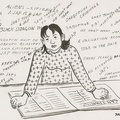It was almost 20 years ago when I read an article by Dexter Waugh in the San Francisco Examiner titled “Semantic debates on war camps” (May 7, 1976). The issue revolved around the use of terminology on a plaque commemorating Tule Lake as a state historic landmark.
At the time I exchanged several letters with the chair of the State Historical Resources Commission, a fellow anthropologist, who voted against the use of the term “concentration camp”, saying that he did not believe in editorializing on these plaques. I argued that we should call what Webster calls them: “places where political prisoners are placed under armed guards.” Furthermore, to use “relocation center” was actually editorializing as it is a euphemism used by those governmental officials who had stripped the Japanese Americans of their basic constitutional rights.
The debate had begun in 1973, when Manzanar was established as a state historic site, in arguments before the State Historical Resources Commission. The late Edison Uno, as a spokesperson for JACL, appeared to state our case. Although the Commission voted against the plea of the Japanese Americans at these hearings, the State Director of Parks and Recreation overruled the Commission and the term “concentration camp” appears on both plaques.
In 1981, Raymond Okamura submitted a comprehensive essay on the subject to the Commission on Wartime Relocation and Internment of Civilians in Seattle. It was subsequently published as “The American Concentration Camps: A Cover-Up Through Euphemistic Terminology” (The Journal of Ethnic Studies 10:3, 1982). Terminological usage continued to be discussed in subsequent actions related to the incarceration of the Japanese Americans such as the annual pilgrimages, the repeal of Executive Order 9066, the Redress Movement and the coram nobis court cases (Fred Korematsu, Gordon Hirabayashi, Minoru Yasui). In view of the discussion over the years, it seems strange that we are still debating the use of terms describing this event.
Let us review the main points of the debate. Over 120,000 residents of the U.S.A., two thirds of whom were American citizens, were incarcerated under armed guard. There were no crimes committed, no trials, and no convictions: the Japanese Americans were political prisoners. To detain American citizens in a site under armed guard surely constitutes a “concentration camp.” But what were the terms used by the government officials who were involved in the process and who had to justify these actions? Raymond Okamura provides us with a detailed list of terms. Let’s consider three such euphemisms: “evacuation,” “relocation,” and “non-aliens.” Earthquake and flood victims are evacuated and relocated. The words refer to moving people in order to rescue and protect them from danger.
The official government policy makers consistently used “evacuation” to refer to the forced removal of the Japanese Americans and the sites were called “relocation centers.” These are euphemisms (Webster: “the substitution of an inoffensive term for one considered offensively explicit”) as the terms do not imply forced removal nor incarceration in enclosures patrolled by armed guards. The masking was intentional. Perhaps the most obvious circumlocution was the use of the term “non-alien.” This phrase appeared on yellow notice sheets affixed to telephone poles announcing the removal orders: “Pursuant to the provisions of Civilian Exclusion Order No. 92, this Headquarters, dated May 23, 1942, all persons of Japanese ancestry, both aliens and non-aliens, will be evacuated from the above area by 12 o’clock noon, P.W.T., Saturday, May 30, 1942.”
Exactly what does “non-alien” mean? To whom does if refer? Of course, it is a euphemism for citizen! Since they were nullifying the constitutional rights of Japanese Americans, it is clear why the government officials did not wish to use the term citizen. According to Okamura, euphemistic language accomplished a number of objectives for using the terms:
(1) it sidetracked legal and constitutional challenges;
(2) it allowed the government to maintain a decent public image;
(3) it helped lead the victims into willing cooperation;
(4) it permitted the white civilian employees to work without self-reproach and
(5) it kept the historical record in the government’s favor.
In spite of the official use of the euphemism “relocation center,” however, many government officials actually used the term concentration camp including President Franklin D. Roosevelt, General Dwight D. Eisenhower, Secretary of the Interior Harold Ickes, Attorney General Francis Biddle and Supreme Court Justices Owen Roberts, Hugo Black and Tom Clark.
The harm in continuing to use the government’s euphemisms is that it disguises or softens the reality which subsequently has been legally recognized as a grave error. The actions abrogated some fundamental principles underlying the Constitution, the very document under which we govern ourselves. This erosion of fundamental rights has consequences for all citizens of our society and we must see that it is never repeated.
Some have argued that the Nazi Germany camps during the Holocaust were concentration camps and to refer to the Japanese American camps likewise would be an affront to the Jews. It is certainly true that the Japanese Americans did not suffer the harsh fate of the Jews in the terrible concentration camps or death camps where Nazi Germany practiced a policy of genocide. Although the loss of life was minimal in America’s concentration camps, it does not negate the reality of the unconstitutional incarceration of Japanese American citizens.
Michi and Walter Weglyn’s research concerning Nazi Germany’s euphemisms for their concentration camps revealed such phrases as “protective custody camps,” “reception centers,” and “transit camps.” Ironically, two Nazi euphemisms were identical to our government’s usage: “assembly centers” and “relocation centers”.
It might be well to point out, also, that the Nazis were not operating under the U.S. Constitution. Comparisons usually neglect to point out that Hitler was operating under the rules of the Third Reich. In America all three branches of the U.S. government, ostensibly operating under the U.S. Constitution, ignored the Bill of Rights in order to incarcerate Japanese Americans.
“Detention camps” and “internment camps” have also been used to refer to the concentration camps. These terms are preferable to “relocation center” as they both imply involuntary confinement. However, Aiko Herzig as well as Brian Niya in Japanese American History (p. 176) argue that the term “internment camps” should be reserved for the justice department internment camps. The largest of them was the Crystal City, Texas camp which housed Issei men with families who opted to stay with them as well as a group of Japanese Peruvians. Other internment camps were in Santa Fe, New Mexico; Fort Missoula, Montana; Fort Lincoln, North Dakota; Kenedy, Texas; and Kooskia, Idaho.
It has been over fifty years since the incarceration of Japanese Americans and the issue of terminology was first raised. Now, as the Museum prepared to mount an exhibition on our wartime experience, Karen Ishizuka, the curator, consulted with the Museum’s exhibit team, other staff, members of the Japanese American and Jewish American communities, and representatives of the general public. The decision was to use the words concentration camp and incarceration to refer to the experience of Japanese Americans during World War II. The use of euphemisms such as assembly, reception, relocation, resettlement and evacuation will be disavowed except as reference to government usage.
The mission of the Japanese American National Museum is to “make known the Japanese American experience as an integral part of our nation’s heritage to improve understanding and appreciation for America’s ethnic and cultural diversity.” This story will be told from the perspective of Japanese Americans but it will be presented within the larger context of American history. It is critical that this important period in U.S. history be examined accurately, without the use of euphemisms.
A basic aim of the Museum is educational. In this process, the staff of the Museum and the public that it serves must learn about our past, together rejoicing in our triumphs and learning from our errors. We need to recognize when our country strays from its fundamental principles and to insure that it will not happen in the future. The lesson here is that the abrogation of rights for any citizen is an erosion of rights for all citizens.
* In preparation of the Enduring Communities National Conference (July 3-6, 2008 in Denver, CO), we are posting an article by James Hirabayashi that was originally published in the Japanese American National Museum Quarterly in the fall of 1994. James Hirabayashi will be a featured speaker at the National Conference in a panel titled, "Words Matter: Language and the World War II Japanese American Experience ." -ed.
© 1994 James A. Hirabayashi






